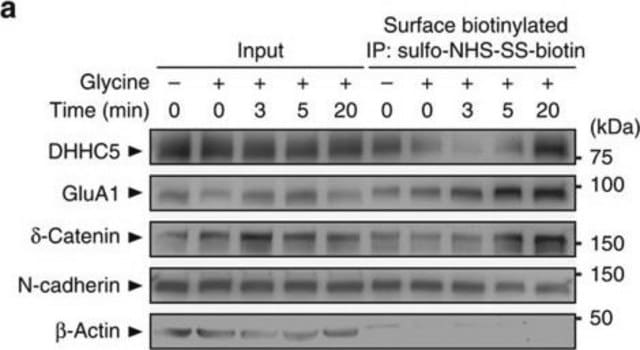MABN1573
Anti-Synapsin-2 Antibody, clone 19.4
clone 19.4, from mouse
Sinonimo/i:
Synapsin II, Synapsin-2
About This Item
Prodotti consigliati
Origine biologica
mouse
Livello qualitativo
Forma dell’anticorpo
purified immunoglobulin
Tipo di anticorpo
primary antibodies
Clone
19.4, monoclonal
Reattività contro le specie
rat, mouse, human
tecniche
activity assay: suitable
immunohistochemistry: suitable (paraffin)
immunoprecipitation (IP): suitable
western blot: suitable
Isotipo
IgG2aκ
N° accesso NCBI
N° accesso UniProt
Condizioni di spedizione
dry ice
modifica post-traduzionali bersaglio
unmodified
Informazioni sul gene
human ... SYN2(6854)
Descrizione generale
Specificità
Immunogeno
Applicazioni
Western Blotting Analysis: Target detection by a representative lot was blocked by a preincubation with phage particles displaying peptides containing the SYIxN consensus sequence (Vaccaro, P., et al. (1997). Brain Res. Mol. Brain Res. 52(1):1-16).
Western Blotting Analysis: A representative lot detected synapsin IIa/IIb, but not Ia/Ib, in rat brain cytosolic extracts (Vaccaro, P., et al. (1997). Brain Res. Mol. Brain Res. 52(1):1-16).
Immunoprecipitation Analysis: A representative lot immunoprecipitated synapsin IIa/IIb, but not Ia/Ib, from rat brain synaptosomal preparations (Vaccaro, P., et al. (1997). Brain Res. Mol. Brain Res. 52(1):1-16).
Enzyme Assay Analysis: A representative lot, when added 2 hours prior to cAMP, prevented PKA-catalyzed phosphorylation of synapsin IIa/IIb in an in vitro kinase assay using rat brain synaptosomal preparations (Vaccaro, P., et al. (1997). Brain Res. Mol. Brain Res. 52(1):1-16).
Neuroscience
Developmental Neuroscience
Qualità
Western Blotting Analysis: 0.5 µg/mL of this antibody detected Synapsin-2 in 10 µg of rat brain tissue lysate.
Descrizione del bersaglio
Stato fisico
Stoccaggio e stabilità
Handling Recommendations: Upon receipt and prior to removing the cap, centrifuge the vial and gently mix the solution. Aliquot into microcentrifuge tubes and store at -20°C. Avoid repeated freeze/thaw cycles, which may damage IgG and affect product performance.
Altre note
Esclusione di responsabilità
Non trovi il prodotto giusto?
Prova il nostro Motore di ricerca dei prodotti.
Codice della classe di stoccaggio
12 - Non Combustible Liquids
Classe di pericolosità dell'acqua (WGK)
WGK 2
Punto d’infiammabilità (°F)
Not applicable
Punto d’infiammabilità (°C)
Not applicable
Certificati d'analisi (COA)
Cerca il Certificati d'analisi (COA) digitando il numero di lotto/batch corrispondente. I numeri di lotto o di batch sono stampati sull'etichetta dei prodotti dopo la parola ‘Lotto’ o ‘Batch’.
Possiedi già questo prodotto?
I documenti relativi ai prodotti acquistati recentemente sono disponibili nell’Archivio dei documenti.
Il team dei nostri ricercatori vanta grande esperienza in tutte le aree della ricerca quali Life Science, scienza dei materiali, sintesi chimica, cromatografia, discipline analitiche, ecc..
Contatta l'Assistenza Tecnica.








